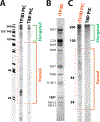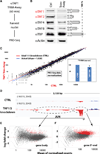TFIID Enables RNA Polymerase II Promoter-Proximal Pausing
- PMID: 32229306
- PMCID: PMC7245555
- DOI: 10.1016/j.molcel.2020.03.008
TFIID Enables RNA Polymerase II Promoter-Proximal Pausing
Abstract
RNA polymerase II (RNAPII) transcription is governed by the pre-initiation complex (PIC), which contains TFIIA, TFIIB, TFIID, TFIIE, TFIIF, TFIIH, RNAPII, and Mediator. After initiation, RNAPII enzymes pause after transcribing less than 100 bases; precisely how RNAPII pausing is enforced and regulated remains unclear. To address specific mechanistic questions, we reconstituted human RNAPII promoter-proximal pausing in vitro, entirely with purified factors (no extracts). As expected, NELF and DSIF increased pausing, and P-TEFb promoted pause release. Unexpectedly, the PIC alone was sufficient to reconstitute pausing, suggesting RNAPII pausing is an inherent PIC function. In agreement, pausing was lost upon replacement of the TFIID complex with TATA-binding protein (TBP), and PRO-seq experiments revealed widespread disruption of RNAPII pausing upon acute depletion (t = 60 min) of TFIID subunits in human or Drosophila cells. These results establish a TFIID requirement for RNAPII pausing and suggest pause regulatory factors may function directly or indirectly through TFIID.
Keywords: DSIF; NELF; P-TEFb; PRO-seq; RNA polymerase II; TAF1; TBP; TFIID; TRIM-Away; pausing.
Copyright © 2020 Elsevier Inc. All rights reserved.
Conflict of interest statement
Declaration of Interests The authors declare no competing interests.
Figures




Similar articles
-
Identification of Regions in the Spt5 Subunit of DRB Sensitivity-inducing Factor (DSIF) That Are Involved in Promoter-proximal Pausing.J Biol Chem. 2017 Mar 31;292(13):5555-5570. doi: 10.1074/jbc.M116.760751. Epub 2017 Feb 17. J Biol Chem. 2017. PMID: 28213523 Free PMC article.
-
More pieces to the puzzle: recent structural insights into class II transcription initiation.Curr Opin Struct Biol. 2014 Feb;24:91-7. doi: 10.1016/j.sbi.2013.12.005. Epub 2014 Jan 16. Curr Opin Struct Biol. 2014. PMID: 24440461 Review.
-
Interactions between DSIF (DRB sensitivity inducing factor), NELF (negative elongation factor), and the Drosophila RNA polymerase II transcription elongation complex.Proc Natl Acad Sci U S A. 2010 Jun 22;107(25):11301-6. doi: 10.1073/pnas.1000681107. Epub 2010 Jun 4. Proc Natl Acad Sci U S A. 2010. PMID: 20534440 Free PMC article.
-
TAF4 nucleates a core subcomplex of TFIID and mediates activated transcription from a TATA-less promoter.Proc Natl Acad Sci U S A. 2006 Aug 15;103(33):12347-52. doi: 10.1073/pnas.0605499103. Epub 2006 Aug 8. Proc Natl Acad Sci U S A. 2006. PMID: 16895980 Free PMC article.
-
Structural insights into assembly of transcription preinitiation complex.Curr Opin Struct Biol. 2022 Aug;75:102404. doi: 10.1016/j.sbi.2022.102404. Epub 2022 Jun 11. Curr Opin Struct Biol. 2022. PMID: 35700575 Review.
Cited by
-
Model-based characterization of the equilibrium dynamics of transcription initiation and promoter-proximal pausing in human cells.Nucleic Acids Res. 2023 Nov 27;51(21):e106. doi: 10.1093/nar/gkad843. Nucleic Acids Res. 2023. PMID: 37889042 Free PMC article.
-
Pharmacologic targeting of the P-TEFb complex as a therapeutic strategy for chronic myeloid leukemia.Cell Commun Signal. 2021 Aug 9;19(1):83. doi: 10.1186/s12964-021-00764-5. Cell Commun Signal. 2021. PMID: 34372855 Free PMC article.
-
The CTD Is Not Essential for the Post-Initiation Control of RNA Polymerase II Activity.J Mol Biol. 2020 Sep 4;432(19):5489-5498. doi: 10.1016/j.jmb.2020.07.010. Epub 2020 Jul 21. J Mol Biol. 2020. PMID: 32707132 Free PMC article.
-
Transcription Pause and Escape in Neurodevelopmental Disorders.Front Neurosci. 2022 May 9;16:846272. doi: 10.3389/fnins.2022.846272. eCollection 2022. Front Neurosci. 2022. PMID: 35615272 Free PMC article. Review.
-
PRO-IP-seq tracks molecular modifications of engaged Pol II complexes at nucleotide resolution.Nat Commun. 2023 Nov 3;14(1):7039. doi: 10.1038/s41467-023-42715-3. Nat Commun. 2023. PMID: 37923726 Free PMC article.
References
-
- Adelman K, Marr MT, Werner J, Saunders A, Ni Z, Andrulis ED, and Lis JT (2005). Efficient release from promoter-proximal stall sites requires transcript cleavage factor TFIIS. Mol Cell 17, 103–112. - PubMed
Publication types
MeSH terms
Substances
Grants and funding
LinkOut - more resources
Full Text Sources
Other Literature Sources
Molecular Biology Databases
Research Materials

